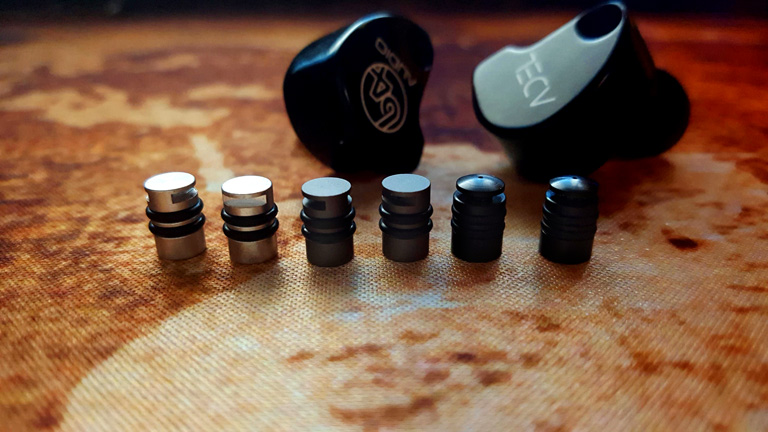
::Disclaimer::
64Audio gave me these two modules in exchange for my honest review, for good or ill.
The M20 and M15 Modules are sold for $99.00 a set.
64Audio.com
————————
One of the greatest things I’ve discovered in my pursuit of better audio is the 64Audio U12 combined with the ADEL B1 Module. When Asius (the makers of ADEL) broke off their partnership with 64Audio, Pinky was dismayed. The finest IEM I’d ever heard was now the last of its kind. To replace Asius’ ADEL, 64Audio rolled out something called APEX. I’ll be honest with you, I had serious doubts the new APEX technology could compete.
First, let me explain why these modules are even a thing.
In-Ear Monitors make a vacuum seal in your ear canal, trapping the air inside. When the driver actuates, it moves that air, air which has no place to go, and your ear drum takes some abuse. This leads to ear fatigue, and over time can cause hearing loss. It’s just not how your ears were meant to handle sound.
The idea behind both techs is to relieve that air pressure, without sacrificing sound quality.
So let us dissect how these two designs differ from one another. Bear with me here. I’m a layman at best. At worst, a degenerate scoundrel. My grasp of this subject is loose and slippery.

Left: APEX M20 Middle: APEX M15 Right: ADEL B1
ADEL stands for Ambrose Diaphonic Ear Lens. A name which perfectly encapsulates the design of the product. Invented by Stephen Ambrose, it’s a diaphragm which filters out pneumatic pressure, while holding in much of the sound pressure. The lens works as a second ear drum, taking the brunt of the vibrations and passing that pneumatic pressure out into the wild. Your ear drum relaxes, reacting only to sound pressure, as it is meant to.
APEX stands for Air Pressure Exchange. There’s a lot less information about how the internals work. It’s a port. There are filters of some nature. You won’t find an ear lens/diaphragm inside, but APEX supposedly filters out pneumatic pressure, while keeping sound pressure. How does it do this? No idea. The claim is that it simply does.
There is quite a bit of evidence that suggests ADEL helps with ear fatigue, tinnitus, and hearing loss. Whereas I’ve found nothing that shows APEX accomplishes the same. But that’s above my pay grade. I don’t have tinnitus, so I can’t even speak on which company best sooths said ailment. My purpose in life is not to validate or discredit scientific research. Couldn’t if I wanted to; I’m no scientist. What I am is an audiophile, and as such, the first and last authority on quality of sound, as perceived by me.
On that front, APEX achieves its goal. It sounds damn good.
The M15 Module gives my U12 a great, spacious sound. Isolation is rated at -15dB, which I find suitable for most environments. With music playing, you won’t hear much from outside. It takes some rather loud ruckus to bleed over the tunes. Details come through sharp and clear. There’s a degree of crispness to the music that I haven’t heard from the U12 before. Vocals and treble are slightly better defined with extra clarity. The Bass is bigger, and hits harder. You can discern the textures easier than with any other module.
The M20 is the APEX bass monster. Isolation is up to a whopping -20dB, so the U12’s 4X low-end drivers are felt in full. And oh mother of God, it is spectacular! As with all spectacular things, a little goes a long way. I find it too much for long listening sessions. Short intervals can be fun, however. The M20 also narrows the soundstage, and a lot of that clarity I loved in the M15 is overshadowed by the terror below. Overall, I didn’t stay very long in the M20’s company. I prefer the other modules more. Your tastes may vary.
My introduction to the U12 was via the ADEL B1 Module. It’s all I’ve known since I bought them back in Sept 2016. Compared to the APEX tech, the B1 sounds softer, with less resolution. Isolation is the lowest of the bunch, at -10dB. It has more of that open-back, full-size headphone feel. It’s remarkably close to the Sennheiser HD650 in tone and open nature. The bass is only a little less than the M15, and does not strike as decisively. Treble seems softer and not as keen. The soundstage is more or less equal to that found with the M15 Module. As a whole, the music presents more relaxed, and maybe a touch more natural.
Which you prefer will be determined entirely by your personal taste in signature and style.
In my review of the U12, I put great significance on the ADEL tech, and attributed perhaps too much of the sound quality to this little thing. I think 64Audio was annoyed by that. They sent me these APEX Modules for review, I suspect, so I’d remember the U12 is a world class IEM, not because of variations in module design, but rather because 64Aduio knows their shit backwards and forward. APEX or ADEL… who knows how alike or unalike they really are. At the heart of it all is a mighty earphone that performs at the top-tier level with the very best of them.
-~::Pinky_Powers::~-


